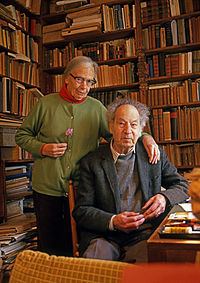Henri Friedlaender (1904–1996) was an Israeli typographer and book designer. He co-founded the Hadassah Printing School and served as the first director of the school.
He was born in Lyon, France in 1904 to a British mother, Rose Calmann and a German-Jewish father, Théodore Friedlaender, who was a silk merchant. His sister was the ceramic artist Marguerite Wildenhain. At the age of six the family moved to Berlin where he attended the Mommsen-Gymnasium. In 1925, he moved to Leipzig, where he studied calligraphy and printing in Leipzig Academy of Graphic Arts.[2]
Career and Personal Life
In 1930, Friedlaender started working on the Hebrew typeface Hadassah in Germany. He later worked with B. G. Teubner and with Wirth in Dresden, with Jakob Hegner in Hellerau, and for the Klingspor Type Foundry with Max Dorn. After working with Rudolf Koch he became a typographic designer with Hartung in Hamburg and later a printer and manager with Haag-Drugulin in Leipzig with Ernst Kellner. In 1932, Friedlaender immigrated to the Netherlands where he worked as art director of Druckerei Mounton & Co. in The Hague. In 1940 Friedlaender married Maria Helena Bruhn, a gymnastics teacher. Due to the Nazi occupation restrictions he had to stop his professional activities and hide in the attic of his house in Wassenaar. Between 1940 and 1945 he was totally isolated, communicating only with his wife who, herself not being Jewish, could overtly make a living. In these years he continued to work for the Exilliteratur publishers Querido and Allert de Lange,[3] and further designed the Hadassah typeface (completed in 1958). In 1950, Friedlaender along with his wife and daughter immigrated to Israel, where he headed the Hadassah-Brandeis Apprentice School of Printing in Jerusalem. Retiring in 1970 he continued to work as a book designer and teacher, and designed three Hebrew typefaces for the IBM Selectric typewriter II typeball (Shalom, Hadar, Aviv).
Friedlaender died in Motza Illit (near Jerusalem) at the age of 92, in 1996 and his wife died in 1994, at the age of 90.
1937 - Silver medal: Exposition Internationale des Arts et Techniques dans la Vie Moderne1950 - Buchpreis (Duwaer-Prijs) der Stadt Amsterdam1954 - La Triennale di Milano1959 - Internationale Buchkunst Ausstellung in Leipzig1971 - Gutenberg Prize.Israel Museum - 1973Tel Aviv Museum of Art - 1985Die Vorbilder der Mediäval und der Antiqua, Archiv für Buchgewerbe und Gebrauchsgraphik, Leipzig: Deutsche Buchgewerbeverein., 1927, 10/12, pp. 726–30Die Buchbinderinnen Dorothea und Katharina Freise, Archiv für Buchgewerbe und Gebrauchsgraphik, Leipzig: Deutsche Buchgewerbeverein., May 1932, pp. 227–32Moderne holländische Druckschriften, Schweizer Graphische Mitteilungen (journal), to 1951. See also Typographische Monatsblätter. Aug. 1948, pp. 336–9 (brief Eng. summary pp. 359, 361)Philobiblon, 1933, p. 1 (self-advertisement)Typografisch ABC, Den Haag, 1939 (written for apprentices at Mouton) (Dutch)De Overweldiger. Hoofdstuk I en II van het boek Habakuk vertaald door Henri Friedlaender (1945) (Dutch)Zijn einde. Jesaja XIV: 3-21 vertaald door Henri Friedlaender (1945) (Dutch)Der Knecht Gottes, (introduction + commentary) Pulvis Viarum (1947) (German)Hoe bereikt men aesthetisch verantwoord zetsel op de zetmachine?, Kerstnummer Drukkersweekblad, Winter 1948 (Dutch)Typographie oder Gebrauchsgraphik?, Schweizer Graphische Mitteilungen (journal), to 1951. See also Typographische Monatsblätter, June 1948, pp. 257–64 (German)Toward a Modern Hebrew. Printing & Graphic Arts. February(1959): 49–56.Modern Hebrew Typefaces. Typographica. 16(1959): 4–9.The history of numerals. Typographica. 1(1960): 48–53.On Letters and Digits. Hadassah Printing School, Jerusalem, 1960. (Hebrew)Book Craft. Hadassah Printing School, Jerusalem, 1962. (Hebrew)Modern Hebrew lettering. Ariel: A quarterly review of the arts and sciences in Israel. 4(1962): 6–15. Print. Jan./Feb.(1964): 81. (Typography – USA seminar).Training by production. Penrose Annual. (1965): 167–173.Die Entstehung meiner Hadassah-Hebräisch, Hamburg: Sichowsky/Christians, 1967. (translated into English: The Making of Hadassah Hebrew. The Typophiles Keepsake. 1975. Israel Bibliophiles newsletter. 4(1984): 1–4.).Von dem Möglichkeiten und den Notwendigkeiten künftiger Buchgestaltung (HF as participant in a symposium with Jan Tschichold and others), Hamburg: Sichowsky/Christians, 1970 (German).Dankwort - Gutenberg Preis, Gutenberg Gesellschaft, Mainz (1971) (German)Contribution to Richard von Sichowsky, Typograph, 1985Color Theory for Printers, 1994 (Hebrew)
